Known as beautiful, brightly colored birds, parrots are one of the most sought after and beloved winged creatures on earth. On the Eighth Continent, or Zealandia, the “new” continent, which lies mostly beneath the surface, birds are the dominant life form – including the Kea vs. Kakapo, two types of parrots found in New Zealand.
Let’s take a look at these unique parrots, what makes them distinctive from one another, and what makes them so darn interesting.
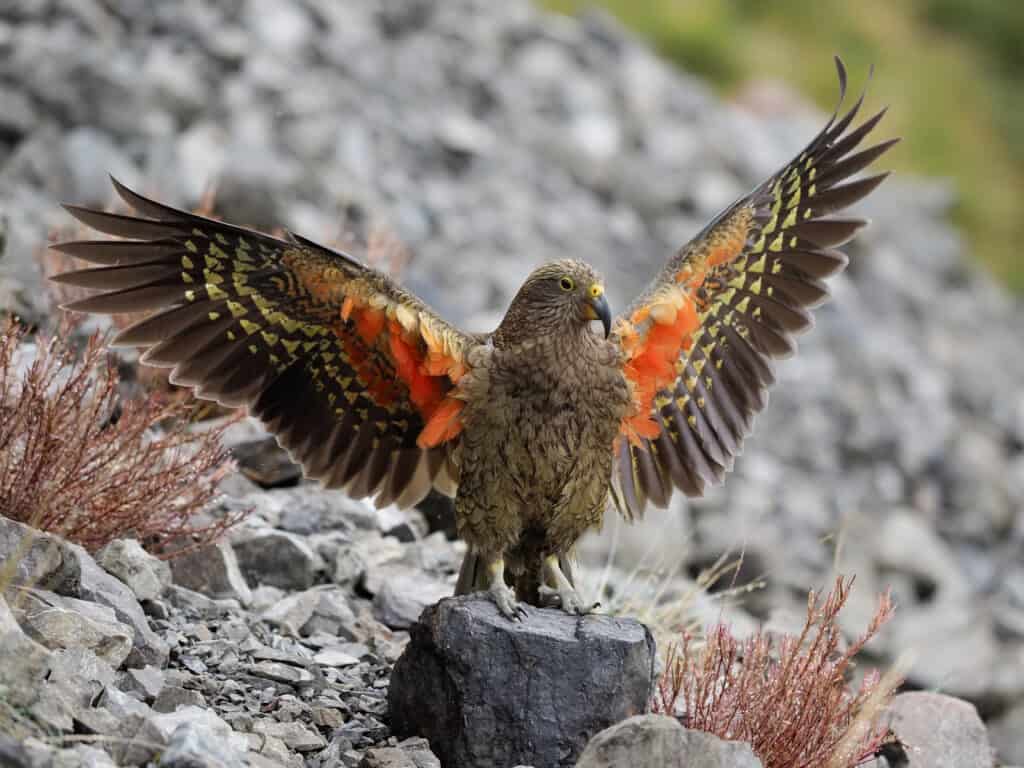
Kea parrot showing off its orange underwings.
©Robert L. Sanson/Shutterstock.com
Kea Vs. Kakapo: Key Differences Summary
| Kea | Kakapo | |
|---|---|---|
| Scientific name | Nestor notabilis | Strigops habroptilus |
| Weight | 1.65 to 2.2 pounds | 2 to 9 pounds |
| Coloration | Olive-green with orange underwings and rump | Moss green with yellow mottling |
| Social behavior | Living in groups of up to 10, poly amorous | Solitary, lek breeding |
| Diet | Plants, grasshoppers, beetle larvae, smaller birds, land snails | Fruits, berries, sap, pollen, seeds |
| Distribution | South Island of New Zealand (in the alps) | Four isolated small New Zealand islands |
| Conservation status | Threatened – Nationally Endangered | Threatened – Critically Endangered |
| Estimated Population | ~5000 | ~250 |
Kea Vs. Kakapo: Classification
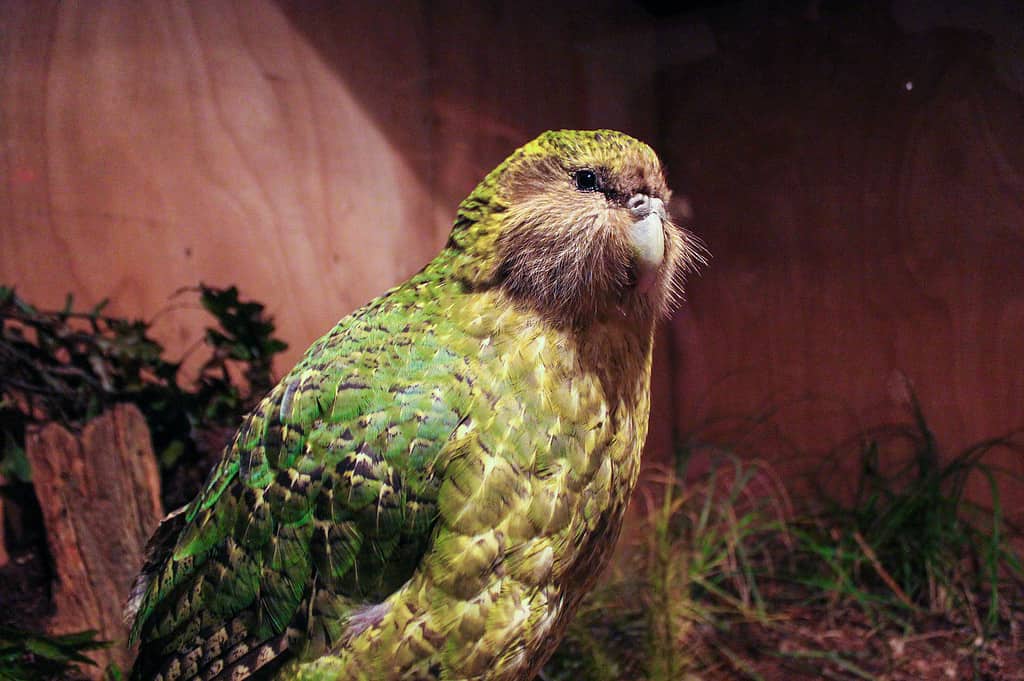
Kakapo sightings are exceedingly rare.
©Imogen Warren/Shutterstock.com
The parrot family of New Zealand Strigopidae has three genera, including Nestor, Strigops, and Nelepsittacus. Each genera contains different parrot species endemic to New Zealand, with Nestor containing the kea and the Strigops containing the kakapo. Both Kea and Kakapo belong to the subfamily Nestorinae within this larger family.
Nestor notabilis, or the Kea, is a large parrot species that dwells in mountains, forests, and alpine shrublands, existing on a omnivorous diet of insects, seeds, and fruits.
Strigops habroptilus, or the Kakapo, was once thought to be its own genus but was later reclassed as part of the Strigops family. The distinct featured borne by the parrot of having more feathers per square inch than any other bird and its flightless lifestyle due to vestigial wings not typically found in parrots.
Kea Vs. Kakapo: Description
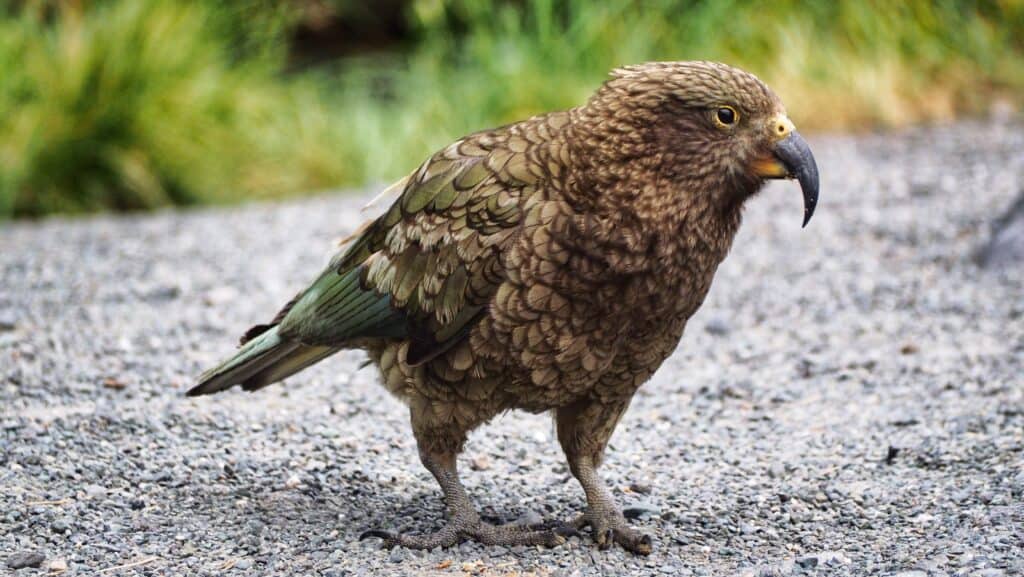
Keas are more muted with their olive-green coloration.
©SAKARET/Shutterstock.com
While the kea and kakapo may look somewhat similar, they are easily distinguishable from one another visually as well.
Both parrots are large and green in color. However, the kea has olive-green plumage with orange underwings and rump. A strong, heavily hook-tipped bill dominates the kea’s face, with the female’s bill being shorter and juveniles having yellow ceres, with adults having grey ceres. Female keas are approximately 20% smaller than males, as well. Keas are typically 18 to 20 inches long in their bodies.
Kakapos are even larger than keas and are distinctly known as the largest flightless parrots in the world. Their rudimentary wings are broad and round, while their plumage is colored green with yellow-brown mottling and bright yellow underparts. Kakapos have owl-like, flat facial discs which help them detect predators at night.
Long legs with feathers covering them down to the talons keep kakapos warm in their native cooler environments. Their large, rounded bodies are usually 23 to 25 inches long, with the birds weighing up to 9 pounds when mature. They are the heaviest living species of parrot in the world.
Kakapos are completely flightless due to the lacking keel on the sternum required for flight muscles. Rather, the birds use their wings for balance and for breaking their falls as they leap around in the trees.
Female kakapos have narrower and less domed heads, longer and narrower beaks than males, and smaller ceres and nostrils. Their legs and feet are pinkish-gray and more slender, and they bear longer tails proportionately.
Kea Vs. Kakapo: Calls
Keas give distinctive long, loud, high-pitched descending cries, often broken up into “kee-ee-aa-aa” or unbroken long “keeeaaaa.” They also produce quiet contact calls, with juveniles squealing or whooping.
A variety of calls may emanate from kakapos, ranging from booms and chings to their loud “skraarks.”
Kea Vs. Kakapo: Behavior
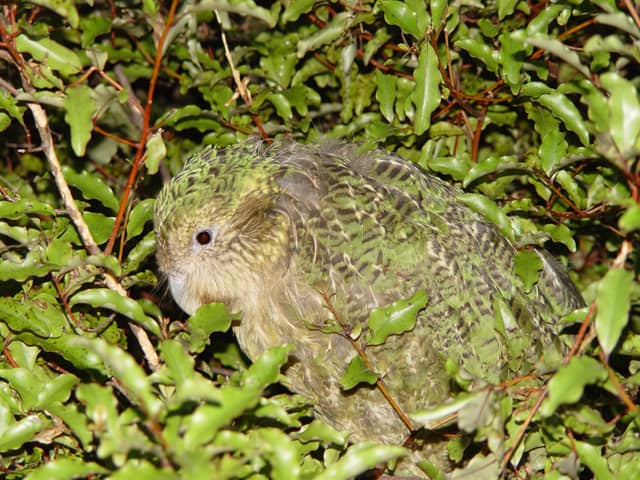
Kakapo, Pounamu, showing how the bird’s plumage acts as camouflage in vegetation.
Considered adventurous and playful, the kea has been observed both playing with snowballs and exploring tourist vehicles near their homes. The high-altitude birds are polyamorous and live in small groups where they display this playful behavior and enjoy the company of one another most of the time. Keas are diurnal, meaning they are most active during the daytime.
The kea is actually the only parrot to live in high mountains (alpine regions), and its personality has earned it the nickname the “naughty alpine parrot” or the “clown of the mountains.” Because of their spirited personalities and lack of fear of humans, they’ve become their own tourist attraction on the South Island of New Zealand.
Kakapos, on the other hand, though once widespread throughout New Zealand, are now rare and hard to spot. They now only survive off the main islands on predator-free islands where mammals have not been imported from the rest of the world. As the world’s heaviest parrots, they’re neither swift nor agile, nor can they fly, making them prone to predation. They rely heavily on their mottled coloring to camouflage them in the environment.
Solitary nocturnal creatures, kakapos rarely interact with others of their species, only doing so during breeding season. The male kakapos put on elaborate mating displays to attract mates. These elaborate displays are competitive in their lek breeding systems, meaning they gather in communal sites and fight it out with their displays. Kakapos are, unfortunately, dwindling in numbers partially due to these intensive displays that “knock out” the competition from being seen as favorable mates by the females.
Kea Vs. Kakapo: Diet
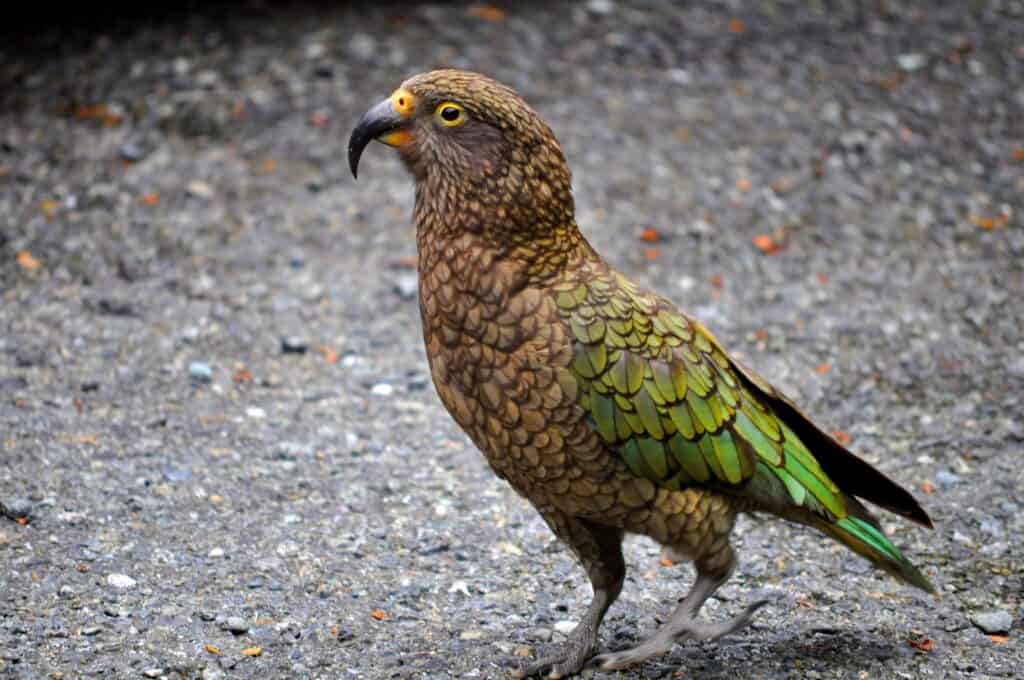
The kea shows off its beautiful green wing plumage and hints of orange and gold in the body and head.
©Olivades/Shutterstock.com
While both parrots are endemic to the same islands, they have widely varied diets from one another. This is partially due to keas as diurnal birds and kakapos as nocturnal birds, as well as kakapos being flightless vs. keas’ ability to fly.
Keas as diurnal flying birds in forests, valleys, mountains, and alpine regions have an eclectic omnivorous diet. Early settlers brought sheep with them and settlers discovered the large parrots actually took to attacking and killing the sheep for their meals. While this could still technically happen, due to the large number of sheep still roaming the pasturelands of New Zealand, the smaller number of keas make this much less likely.
The typical diet of keas is more likely to include:
- Leaves of specific endemic plants
- Flowers
- Fruits
- Berries
- Mosses and lichens
- Nuts
- Buds
- Woody tissue
- Lizards and skinks
- Earthworms and grubs
Kakapos, being flightless nocturnal herbivorous birds mostly feed on fallen fruits like rimu and rata, fungi growing on trees, and other low-lying non-animal based food sources. Rimu is their primary source of food, when in season, with the others only supplementing as needed to round things out.
Kea Vs. Kakapo: Habitat and Distribution
While the kakapo is a solitary animal, the kea appreciates society so much that the birds as a species are actually attracted to humans, not just other keas. The large parrots have often been seen playing around tourist vehicles and hanging out at ski-fields and around mountain huts in their native alpine regions. The birds mainly nest within native forest, with foraging grounds in the forest as well as sup-alpine scrub, herb-field, and tussock.
Ranging over about 4 million hectares of the South Island of New Zealand, keas may be found from Waitutu to Farewell Spit and the Kaikoura Ranges. They reside in coastal dunes but more frequently in montane forests and the nearby alpine and subalpine terrains. Their preferred socialization areas include windy saddles below or above the timberline, pine forests near native forests, and prominent rocky outcroppings.
Prior to human interference, kakapos had an even larger distribution than keas, ranging across both main islands of Aotearoa (New Zealand). There’s no fossil or modern record of them having been in Stewart Island, however. They have been found in scrublands, tussocklands, and coastal areas, in forests dominated by beeches, tawa, and podocarps like rimu and kahikatea. They’ve also been found in areas with slip debris and avalanche terrain in Fiordland, and in heavily fruiting vegetative areas that have become known as “kakapo gardens.”
These birds are habitat generalists, meaning they were widespread and didn’t keep to only specific types of habitats. Now, unfortunately, they are confined to completely predator-free areas, specifically four isolated islands off the mainland coasts, as well as in some ecosanctuaries like Zealandia near Wellington.
Kea Vs. Kakapo: Unique Facts and Significance
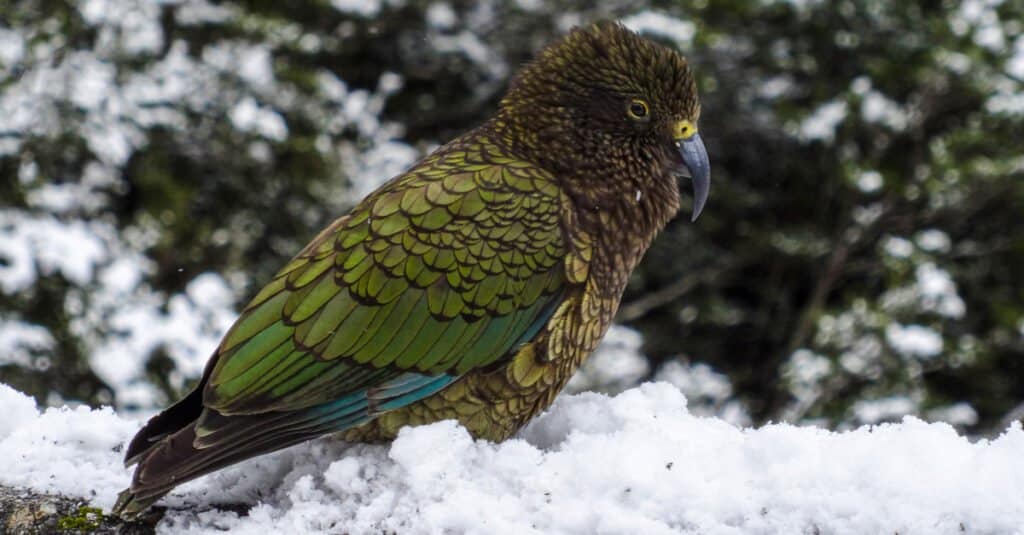
Also called an “owl parrot,” the Kakapo can live up to 100 years. However, there are only around 150-200 known birds that are currently living.
©heather_p/Shutterstock.com
Some interesting facts and cultural significance points about these two birds include:
- Both species became some of the dominant lifeforms in New Zealand largely due to the lack of native mammals in the island nation (the only native mammals are 2 species of bats and marine mammals like dolphins and seals).
- Both bird species have been under threat since the introduction of mammals to New Zealand, largely including mice, rats, cats, dogs, weasels, stoats, ferrets, and hedgehogs.
Kakapos
- Kakapos have failed to adapt to these ground predators, since they are unable to fly, which has largely led to their dramatic population decline.
- Kakapos were once hunted as food by various Maori tribes (iwi). Their skins were then used to create cloaks and formal capes reserved for the wives and daughters of tribal chiefs.
- The kakapo is the only living flightless species of parrot.
- Kakapos are extremely skilled and strong climbers so they don’t only reside on the ground.
- The name kakapo comes from two Maori words combined: kaka, meaning pattor, and po, meaning night. The name, therefore, is night parrot.
Keas
- The origin of the name kea is somewhat foggy but presumed to be from the “keeaa” sound the birds make.
- Keas are believed to be symbolic birds connected to the spiritual realm. Some have thought that keas were the sign of departed relatives or ancestors watching over them or visiting the living.
- Keas naturally trust and appreciate humans. This has unfortunately led largely to the decline in their populations, making them easy targets for humans.
- Keas were first known by settlers as “sheep hunters” as so were hunted as predators of the large mammals.
- Keas were eaten by Maori (indigenous peoples of New Zealand). Though they were believed by the Waitaha tribe to guardians (kaitiaki).
- Keas use tools to get food from difficult sources, like bee hives and pinecones.
- The intelligence levels of keas is often compared to that of chimpanzees.
- Keas are the only known parrot in the world to live in elevations of alpine regions above 1000 meters.
- As conservation efforts arose in the country, bounties for sheep-hunting keas were eliminated in 1971. By 1986, full protection for the birds was finally granted.
The photo featured at the top of this post is ©
Thank you for reading! Have some feedback for us? Contact the AZ Animals editorial team.






